
20-Minute Workout At Home (No Repeats)
This 20-minute, full-body strength workout features a variety of no-repeat, low-impact exercises designed to build strength, improve endurance and enhance functional movement. Ideal for beginners or anyone short on time, it targets the upper-body, lower-body and core using dumbbells. This workout is perfect for boosting total-body strength, mobility and energy right from home.
I used to think a “real” workout had to be at least an hour long, but honestly, 20 minutes of smart, focused strength training can be effective, especially when you’re working out at home. That’s why I love this full-body, no-repeats dumbbell workout. It’s low-impact, beginner-friendly and it targets everything (upper-body, lower-body and core) without ever repeating a move.
The no-repeats format keeps things interesting (and less intimidating), especially on days when motivation is low. While I usually lean into compound exercises to build muscle and strength, mixing it up with a no-repeats session is a great way to keep things fresh.
20 minutes is enough time to get a solid workout done, especially if you’re just getting started. A short, consistent routine can help you build a solid foundation. Even 3-5 quick workouts per week can make a big difference in how you feel and move throughout your day.
You certainly don’t need a gym or complicated equipment to see progress from your workouts. You can build muscle and get stronger with bodyweight exercises or dumbbells. It’s all about using functional, full-body movements like squats, lunges, push-ups, rows, mountain climbers and burpees. These exercises mimic real-life movement patterns, which makes them not just efficient, but practical, too.
Some of my go-to moves for beginners are squat-to-press, reverse lunges, glute bridges, bent-over rows, jumping jacks, crunches and plank variations. These hit multiple muscle groups at once, improve balance and help you build strength that translates into everyday life.
So if all you’ve got is 20 minutes, that’s more than enough! Press play, grab some dumbbells (or just use your bodyweight) and get moving. You’ll be surprised at what you can accomplish in this total body workout.
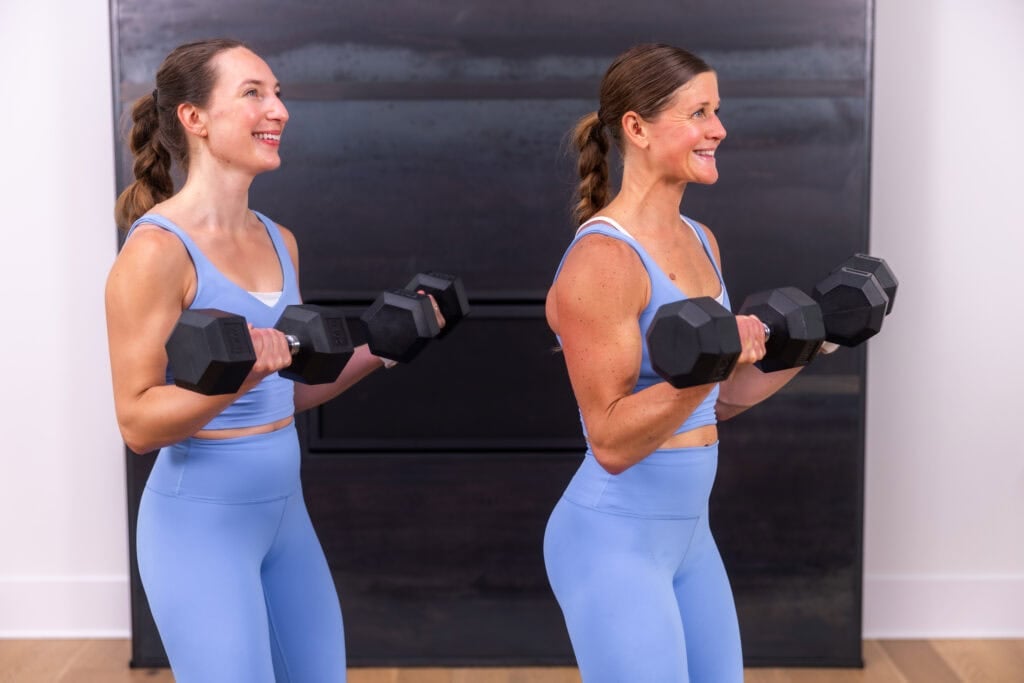
Read A 5-Star Review ⭐⭐⭐⭐⭐
“I liked this workout! Today was a low motivation morning, and I said… only 20 minutes? I can do it. I feel much better now, thank you!”
— Veronica G.
Workout Specifics
Workout Equipment
Medium to Heavy Set of Dumbbells. I recommend between 5-25 lbs, depending on your fitness level. I’m using 15-25 lb dumbbells in today’s workout.
Workout Instructions
Follow along with the guided Full-Body Strength Workout on YouTube, led by me, your certified personal trainer, Lindsey Bomgren.
Your Workout Looks Like This:
- Guided Warm-Up and Cool-Down
- 15 Full Body Dumbbell Exercises (All Standing)
- Timed Intervals (complete each exercise for 40 seconds of work, followed by 20 seconds of rest. Perform as many reps as possible while maintaining proper form during the timed intervals.)
- Repeat Each Exercise x1 Set (No Repeats)
Workout Outline
CIRCUIT 1:
- Legs: Deadlift
- Arms: Alternating Shoulder Press
- Combo: Deadlift and Clean and Shoulder Press
CIRCUIT 2:
- Legs: Wide Squats
- Arms: Back Rows
- Combo: Lateral Squat and Alternating Back Row
CIRCUIT 3:
- Legs: Alternating Reverse Lunges
- Arms: Bicep Curls
- Combo: Curtsy Lunge and Bicep Curl
CIRCUIT 4:
- Legs: Calf Raises
- Arms: Overhead Tricep Extensions
- Combo: Overhead Press and March
CIRCUIT 5:
- Legs: Side-to-Side Squats
- Arms: 3-Way Standing Chest Press
- 3.Combo: Side Step Squat and Chest Press
1. Deadlift
Targets: All the posterior chain muscles, including the hamstrings, glutes, core, lats and lower back.
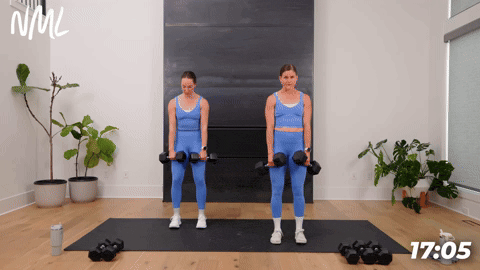
How to Do a Deadlift
- Stand with feet hip-width apart, holding a dumbbell in each hand in front of your hips (palms facing in towards your body).
- Hinge at the hips, pushing your hips back towards the wall behind you as you glide the dumbbells down the front of your legs, keeping your core tight, slightly bending both knees. Lower your dumbbells until you feel a stretch in the hamstrings. The range of motion will look different for everyone.
- Drive through your heels to push your hips forward, pulling the dumbbells back up towards your hips and returning to the starting position.
2. Alternating Shoulder Press
Targets: Both the anterior and lateral heads of the deltoid, rear delts, triceps and upper back muscles.
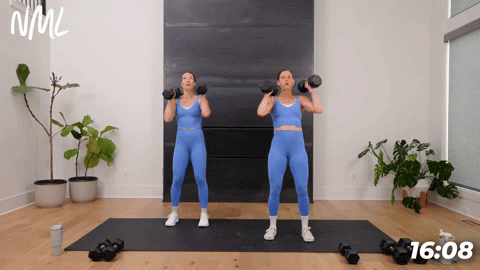
How to Do an Alternating Shoulder Press
- Stand with your feet shoulder-width apart, knees slightly bent. Hold a pair of dumbbells at shoulder height, palms facing in towards each other (neutral grip). Your shoulder blades are pulled back and down.
- Engage your core, slightly tucking your pelvis to protect your lower back. Push the dumbbell in your right hand overhead until your right arm is fully extended. Keep the dumbbell in your left hand racked at your shoulder.
- Lower the dumbbell in your right hand down to shoulder height, returning it to the starting position.
- Switch arms, pushing the dumbbell in your left hand overhead until your left arm is fully extended. Keep the dumbbell in your right hand racked at your shoulder.
- Lower the dumbbell in your left hand down to shoulder height, returning it to the starting position.
3. Wide Squats
Targets: Quads, hamstrings, hips, gluteus medius, outer thighs (abductors) and inner thighs (adductors).
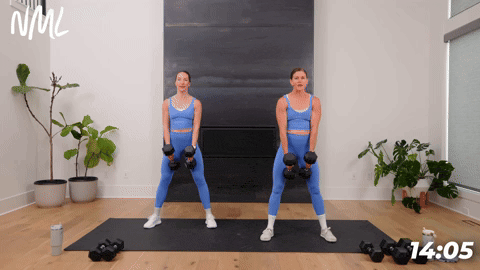
How to Do a Wide Squat
- Stand with your feet wider than your hips, heels in and toes pointed out (sumo squat stance). Hold 2 dumbbells between your legs.
- Bend your knees to lower down into a sumo squat, pushing your knees out towards your pinky toes as you drop your hips parallel to your knees.
- Drive through your heels, squeezing your glutes and pulling your inner thighs together to stand tall.
4. Back Rows
Targets: Latissimus dorsi (or lats; the largest back muscle known for its large, flat “V” shape).
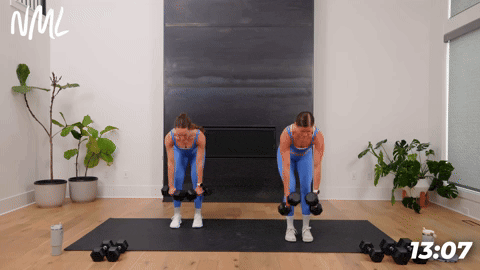
How to Do a Back Row
- Stand with your feet slightly wider than shoulder-width apart, knees slightly bent. Grip a set of dumbbells, palms facing in towards each other.
- Hinge forward at the hips until your body is in a straight line, neck in line with your spine, flat back, and belly button pulled back towards your spine.
- As you pull the weights back towards your hips in a rowing movement, squeeze your shoulder blades together. Stop when your elbows are in line with your hips.
- With control, slowly lower the dumbbells back down to the starting position. Think up on a 1-count, down slow and controlled on a 2-count.
5. Reverse Lunges
Targets: Glutes, quads, hamstrings, hips, thighs and core.
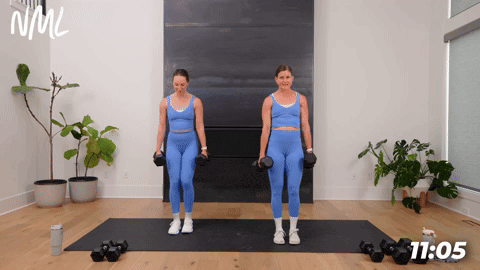
How to Do a Reverse Lunge
- Start standing in a neutral position, feet hip-width apart, holding a dumbbell in each hand, palms facing in towards each other (hammer curl grip).
- Step your left foot back into a reverse lunge. Lower your left knee towards the mat, both knees bent at 90-degree angles. Think about keeping the torso upright.
- Hold for a moment, then drive through your front right heel to return to standing.
- Alternate the movement, this time stepping your right foot back into a reverse lunge.
Modification: If stepping back into a reverse lunge isn’t comfortable, substitute a split squat or split lunge.
6. Bicep Curls
Targets: The biceps brachii (the front of your arms).
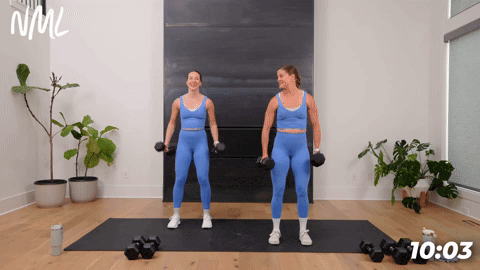
How to Do a Bicep Curl
- Start standing, feet shoulder-width apart and core engaged. Hold a dumbbell in each hand at your sides, palms facing outward (underhand grip or supinated grip).
- Exhale, squeezing the biceps muscle to curl the weights up to shoulder height. Think about keeping your elbows tucked into your sides and your shoulder blades pulled down.
- With control, slowly lower the dumbbells down to your sides. Return to the starting position and repeat.
7. Calf Raises
Targets: Calf muscles (gastrocnemius and soleus) and Achilles tendon.
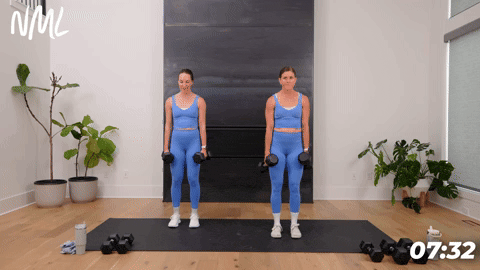
How to Do a Calf Raise
- Start standing on a flat surface, feet shoulder-width apart. Keep your back straight and core engaged to stand tall. Hold a pair of dumbbells in your hands.
- Slowly and with control, lift yourself onto the balls of your feet, heels rising above the ground.
- Lift your heels until you feel a stretch along the back of your legs, balancing on your toes.
- Slowly lower your heels back to the ground, returning to the starting position.
8. Overhead Tricep Extensions
Targets: The long head of the triceps and all the stabilizing muscles in the shoulders, core, glutes and lower back.
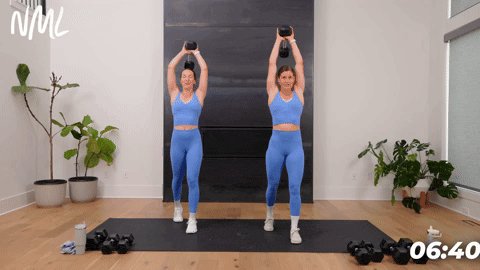
How to Do an Overhead Tricep Extension
- Stand with your feet hip-distance apart, core engaged, and a soft bend in your knees.
- Hold 1 or 2 dumbbells vertically overhead and activate your core by squeezing your glutes and abs to protect your lower back.
- Bend your elbows to a 90-degree angle, bringing the dumbbell(s) behind your head. Think ‘hide the dumbbell, show the dumbbell’ if you were watching yourself in a mirror. Keep your elbows close to your ears throughout the entire movement (don’t let your elbows flare out as you fatigue).
9. Standing Chest Press
Targets: Chest (pectoralis major), shoulders (deltoids), triceps, obliques and core.
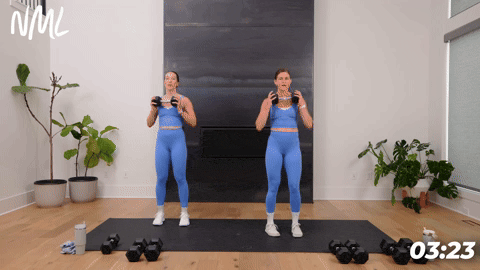
How to Do a Standing Chest Press
- Stand with your feet shoulder-width apart, a soft bend in your knees and your core engaged.
- Hold 1 dumbbell horizontally at chest level. Your palms are facing in and your elbows are slightly tucked. This is your starting position.
- Pivot on your feet 90 degrees to the right, allowing your hips to rotate with control. Once facing right, press the dumbbell straight out in front of you, extending your arms fully while keeping your shoulders down and away from your ears.
- Retract the dumbbell back to your chest, then pivot back to center and press the dumbbell straight out in front of you. Focus on keeping your hips and core tight.
- Return the dumbbell to your chest and pivot 90 degrees to the left. Press out again, fully extending the arms.
- Retract the dumbbell back to your chest, then pivot back to the right and repeat the sequence.
FAQs
An effective 20-minute workout at home will combine compound exercises that target multiple large muscle groups at once (such as your back, shoulders, triceps, glutes, legs and abs). I recommend a combination of dumbbell strength training and no-equipment HIIT cardio to maximize workout results. Be sure to include a quick warm-up and cool-down to help you stay injury-free.
Home workouts can be effective for losing weight and staying fit, as long as you stick with them and use good form. While gyms have more equipment and a dedicated space, working out at home is usually more convenient and flexible. You can get an effective home workout with dumbbells and your bodyweight. Be sure to continue to challenge yourself by implementing various forms of progressive overload.
The best beginner workout plan should combine full-body cardio, strength training and mobility work. That said, the best workout plan is one you’ll follow. Start where you are, and do what you can. If you enjoy movement like Pilates, running or HIIT workouts, you can incorporate those into your beginner workout routine. I recommend following a well-rounded plan for accountability and motivation.
Yes, doing 25 minutes of cardio and 20 minutes of weights 4 times a week is a good workout routine, especially if your goals are strength building, fat burning and weight loss. The CDC recommends 150 minutes of moderate-intensity physical activity and 2 days of muscle-strengthening activity each week. This approach aligns closely with recommended exercise guidelines for both cardiovascular health and strength training.










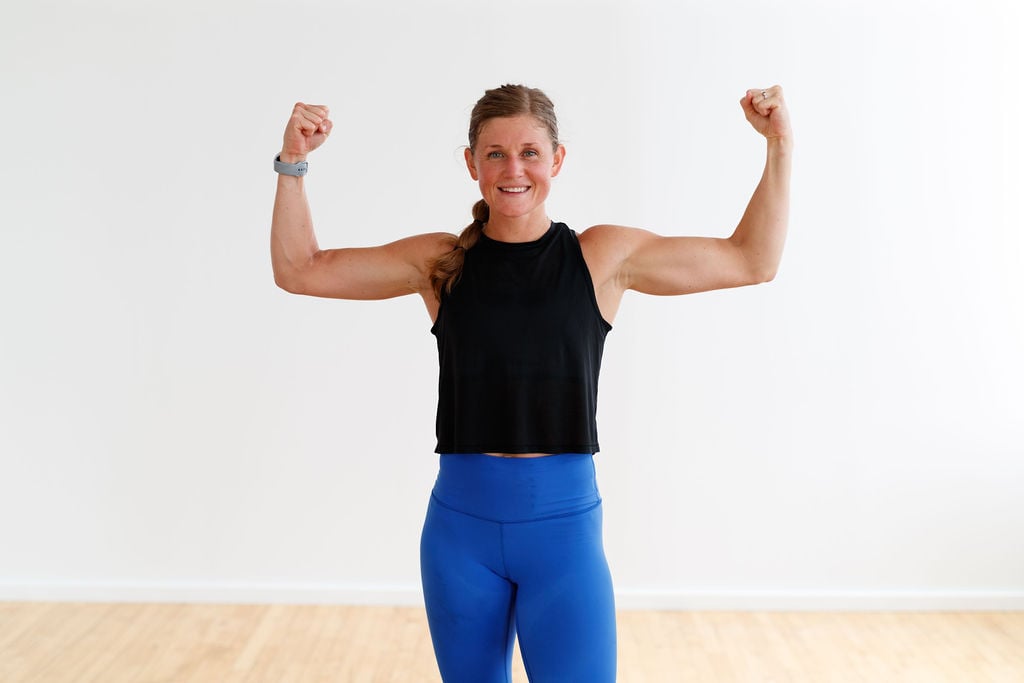

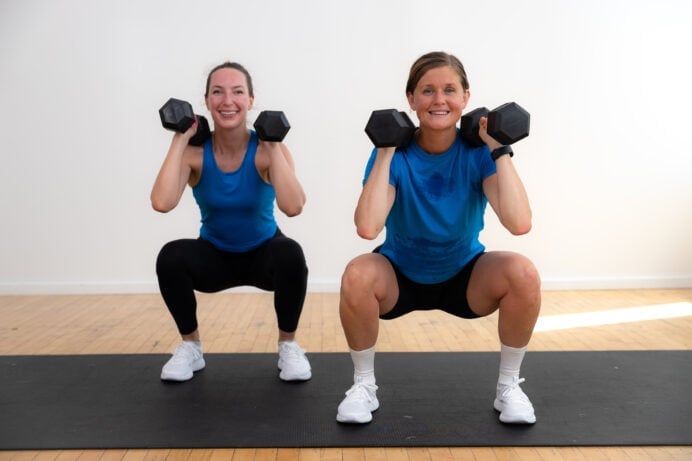
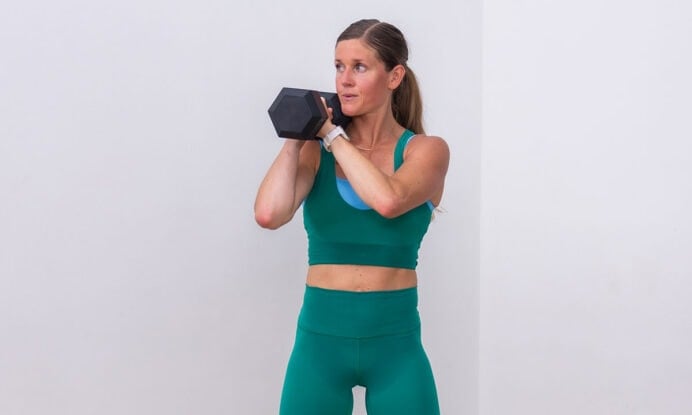
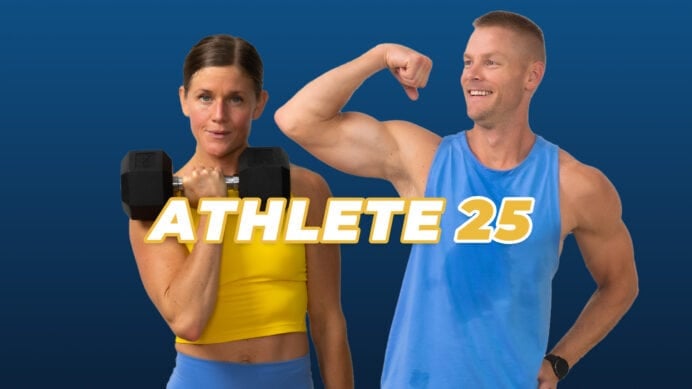
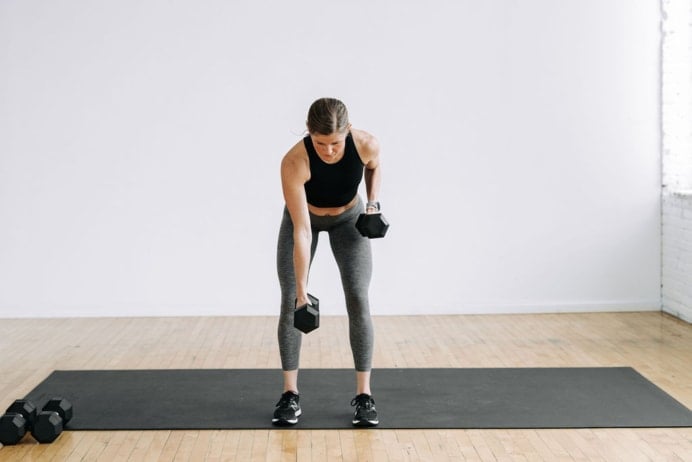
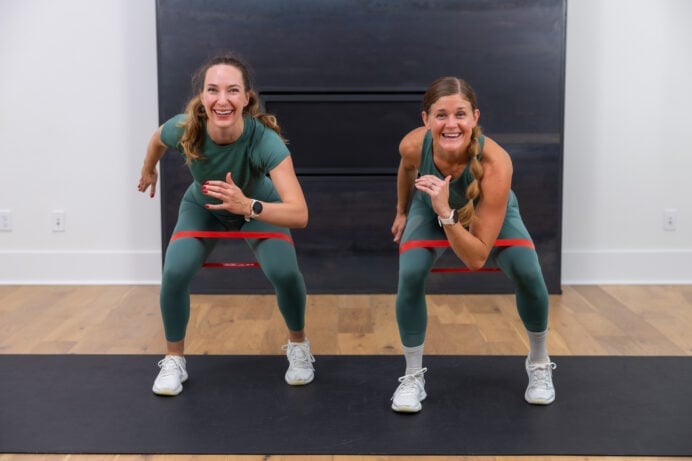
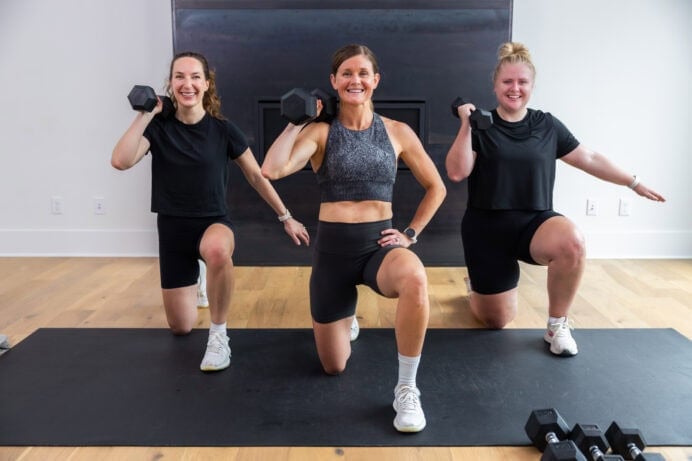
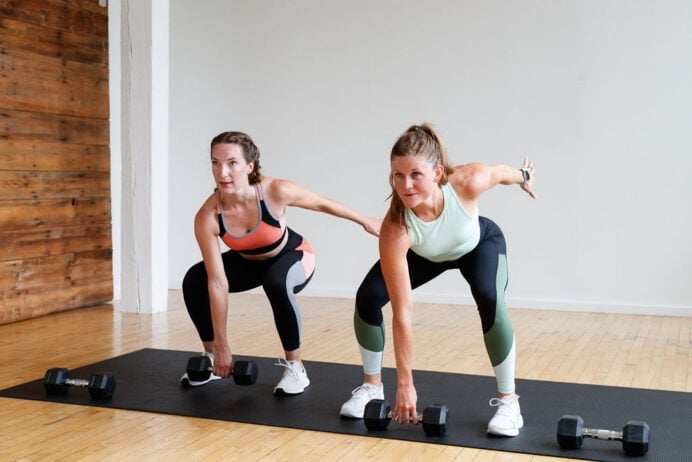
Super!
Thanks for trying this one! Glad you enjoyed it! -Lindsey